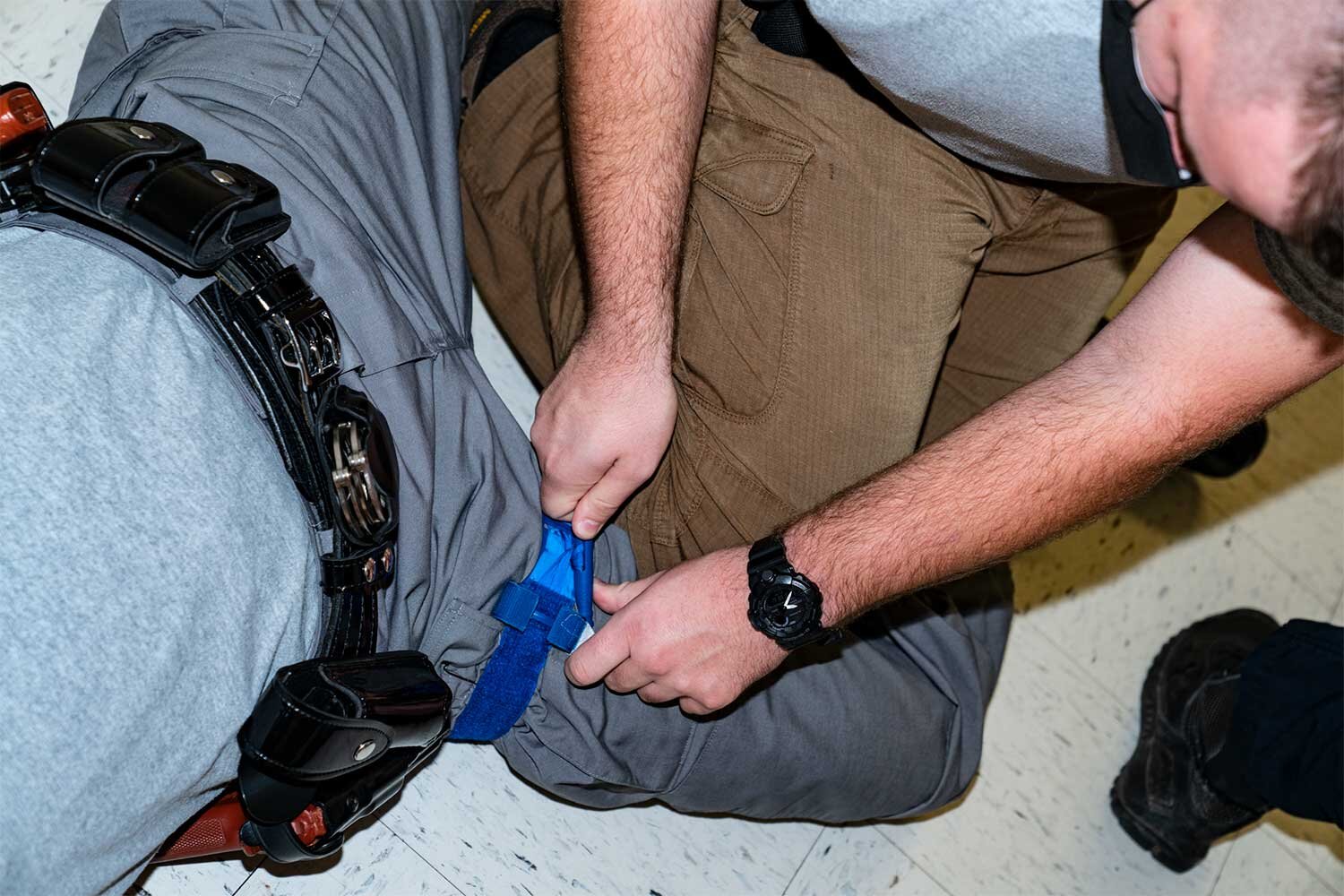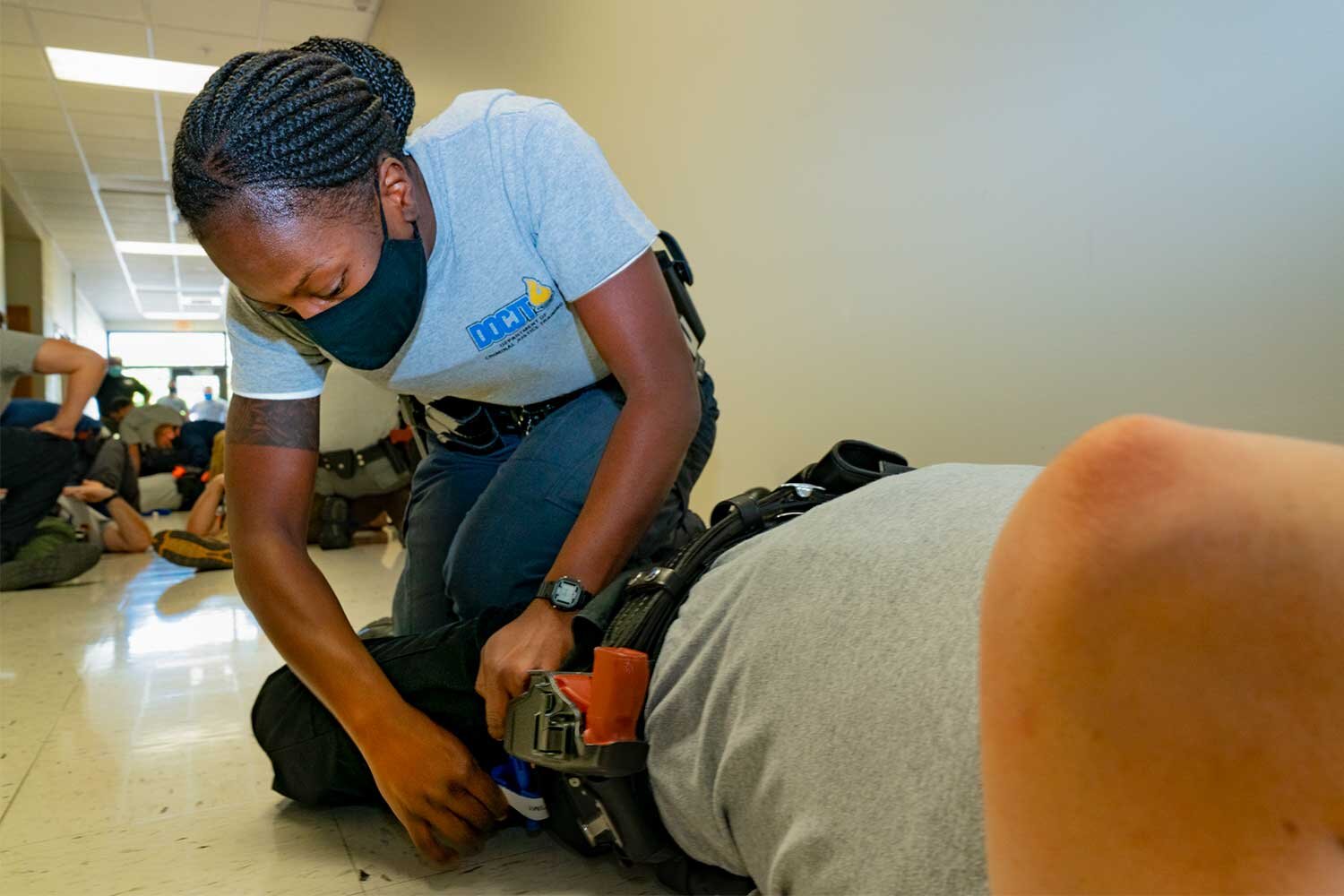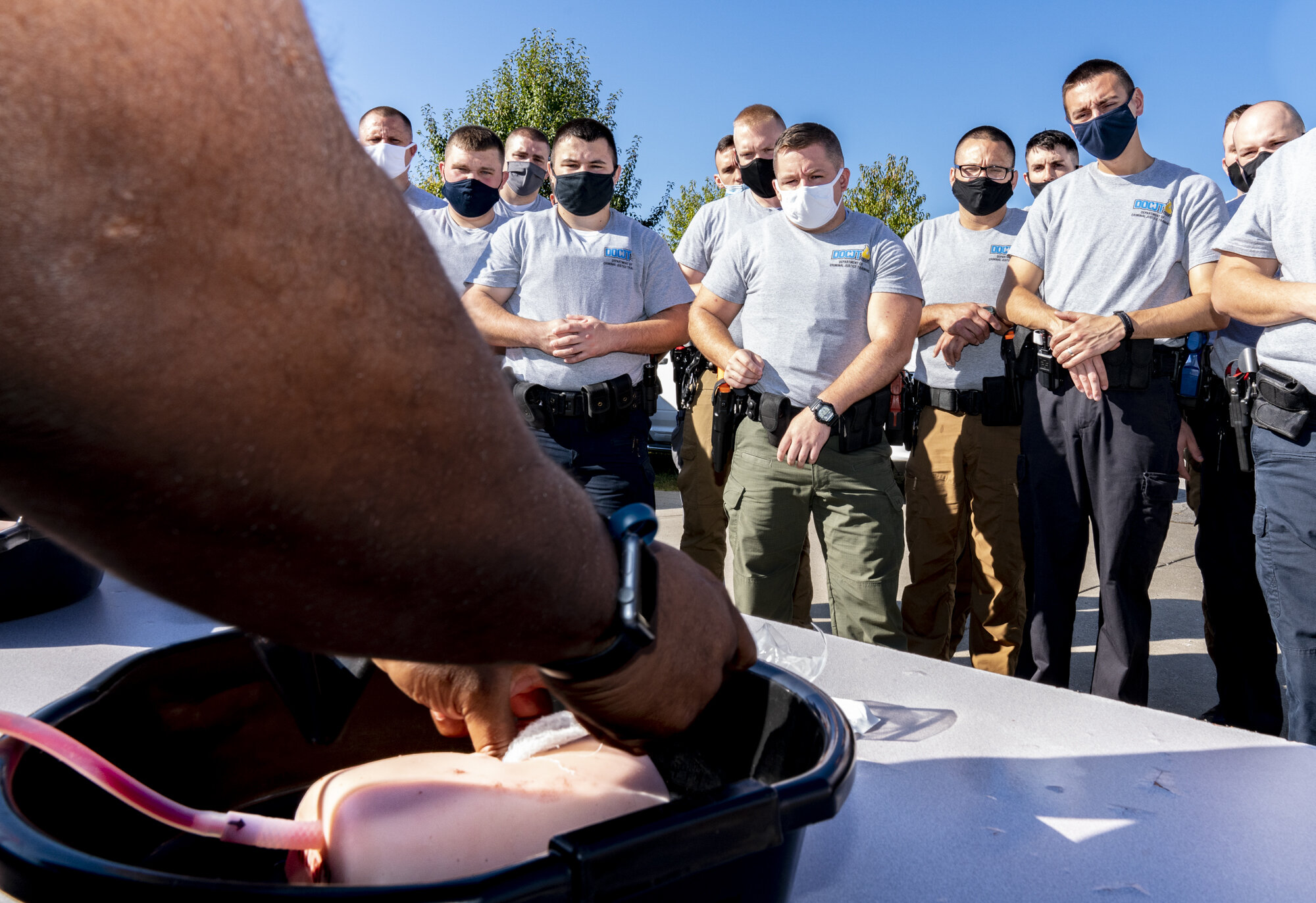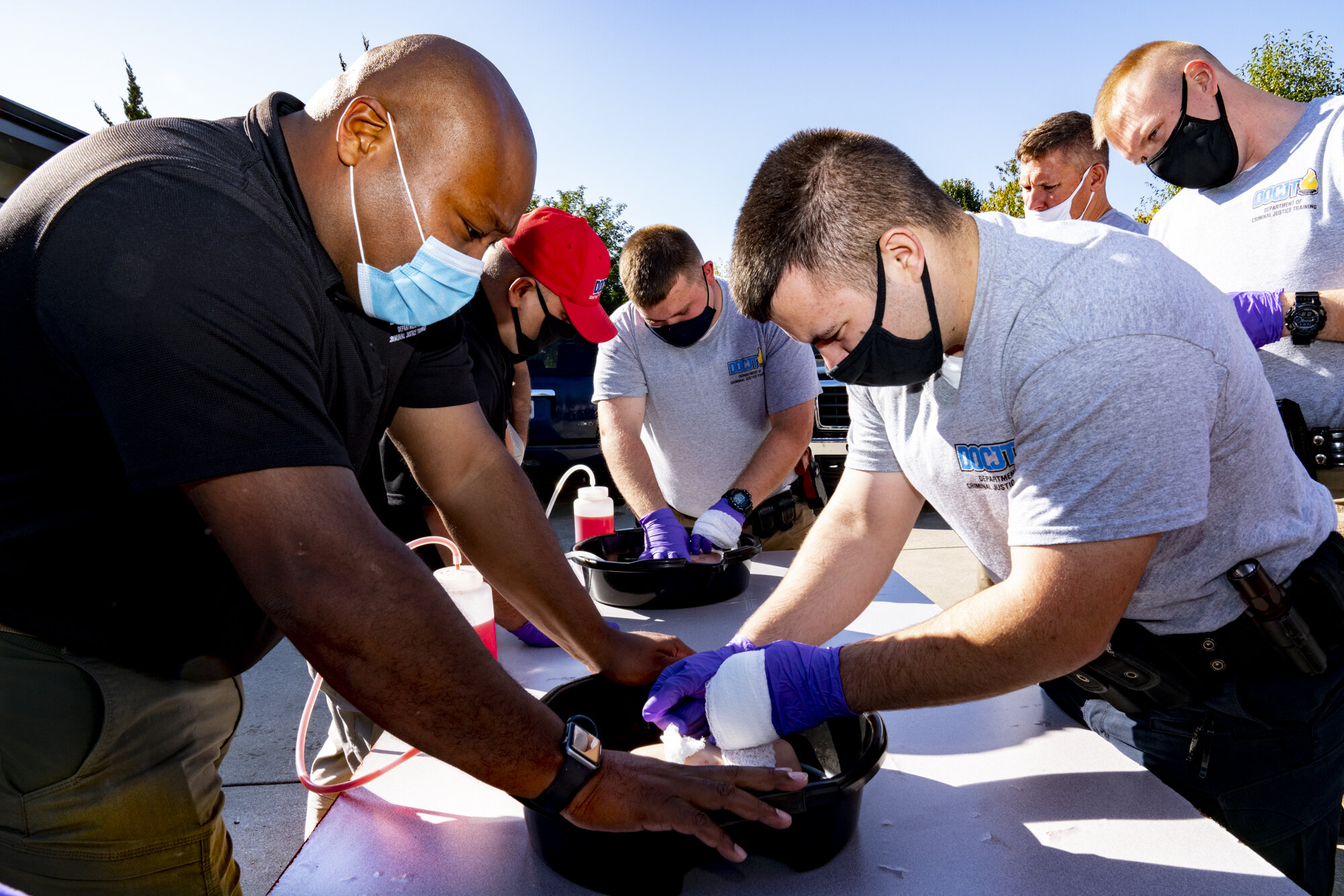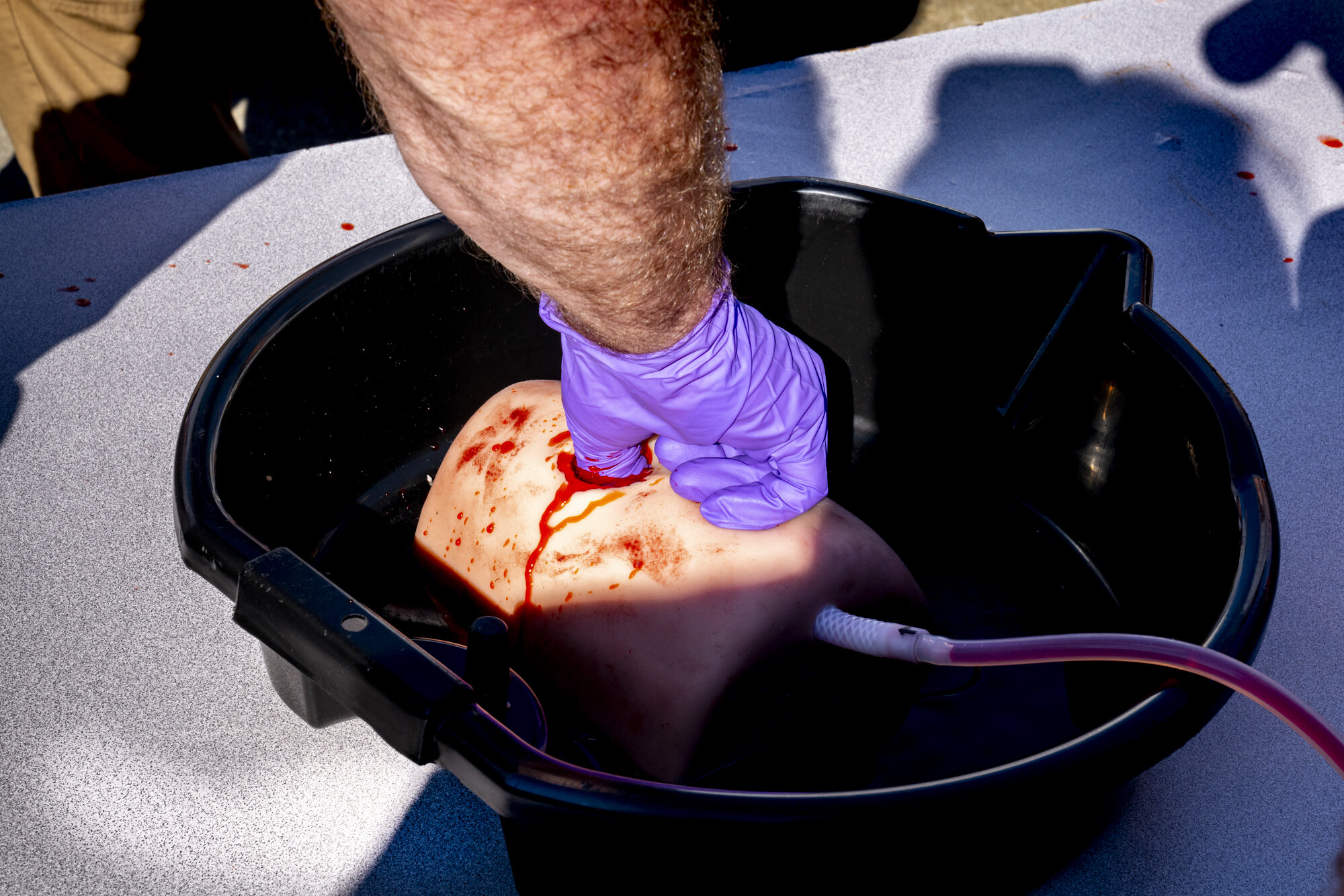Survival Skills
PICTURED ABOVE
DOCJT Instructor Jason Mike demonstrates skills designed to stop bleeding during a recent Tactical Medicine class. (Photo by Jim Robertson)
On any given shift, law enforcement officers could roll up on a scene where someone is seriously hurt, or the officers may be injured themselves. It’s during those times where life and death hangs in the balance as immediate medical attention is needed to save the life of a citizen, another officer or themselves.
While waiting for emergency medical services (EMS) to arrive, why not have the necessary skills to save the person in need?
That is the premise behind the Tactical Medical (Tac-Med) course taught at the Kentucky Department of Criminal Justice Training.
“We’re giving officers a basic medical knowledge to be able to stop bleeding and help with any airway issues they may come across while on duty or even off duty,” DOCJT Instructor Jason Mike said. “We teach them how to apply a tourniquet properly and how to use a trauma bandage to dress and pack the wound and how to apply a chest seal for an injury called a sucking chest wound. We’re giving them the training on top of the equipment they’ll need to do the job.”
Each recruit is issued a small Tac-Med bag with a tourniquet, trauma sheers, trauma bandages and chest seals, Mike said.
“They are trained on the proper use of each item,” he explained.
Modern Policing
In today’s world, events such as those involving an active shooter are on the rise, and often, the police are the first to arrive on the scene. Because of this, Mike said it is becoming more and more imperative for police to have the skills necessary to render aid to the public, other officers, or themselves.
“We want to give officers as many opportunities as possible to be able to render aid in different scenarios, whether they’re on duty or off duty,” Mike said. “We want to make Kentucky safer.
“If we have these officers going around with this medical training, even though it’s basic, it’s more than a layperson will have,” he continued. “They will be able to stop the bleeding, or if they see a sucking chest wound, they can identify it and apply the appropriate measures to stop the bleeding.”
The four-hour course is taught to law enforcement basic training classes and is offered in every active shooter and traffic stops course.
Mike brings a wealth of knowledge and experience to the table on the subject, having served 12 years as a U.S. Army combat medic.
“My last six years, I was with the 20th Special Forces Group as a combat medic,” he explained. “I was lucky enough to have some advanced medical training provided by some great doctors and Special Forces medics who took me under their wing and taught me some excellent skills.
“When I got to DOCJT, it was a natural fit,” he added. “I have the training and background for it, and I’ve been teaching it for 16 years. I’m not teaching people to perform surgery.”
Incident Survival
The need for law enforcement officers to have the basic first aid skills is necessary, as, during an active scene, it is unlikely EMS personnel will be able to arrive and render timely aid.
“If it’s an ongoing scene, the EMS folks aren’t going to get there, for obvious reasons,” Mike explained. “In the past, law enforcement did not do much medical assistance.”
In the interim, the person’s chances of survival diminished significantly.
“(Tac-Med) allows the officer to bridge the gap and stop the bleeding or clear the airway,” Mike said. “If somebody is actively bleeding, we need to stop it. The body only has about five liters of blood, to begin with, so we need to stop the bleeding. Once EMS gets on the scene, the person is stable enough for them to take over because we’ve kept that air going into the body and kept the blood from flowing out.”
Training’s Focus
The training focuses on three common injuries law enforcement officers typically experience, Mike said. Those are obstructed airways, uncontrolled bleeding, and sucking chest wounds.
“The reason we focus on those injuries is based on a study done by U.S. Army Col. Ron Bellamy,” Mike explained. “He looked at 2,500 deaths from the start of the Vietnam Conflict until the end, and he saw the three most common characteristics of the deaths were.”
The statistics revealed in Bellamy’s study holds true in today’s environment with the global war on terror and is right in line with what law enforcement officers see in the field, Mike said.
“Many times, it is accident collisions,” Mike continued. “Officers see injury collisions a lot where people are having uncontrolled bleeding because they are impaled by a fence post or something like that, or they’re having airway issues.”
The key to the training is repetition, Mike said.
“The first few hours of the course is all classroom,” he said. “Then we have tourniquet drills where they place tourniquets on themselves 50 to 100 times. It’s to the point where it becomes muscle memory. We want to make it to the point where they can do it without thinking. Toward the end of the academy, we put them through a drill where they wear blacked-out goggles so they can see, and have to apply a tourniquet when they can’t see; it’s strictly by feel.”
Officer Safety
Proper training helps officers effectively do their jobs, and it keeps them safe. The Tac-Med course is no different, Mike said.
“(Policing) is a dangerous job, and you’re putting a gun on their hip, but you’re not giving them the means just in case they come across a bad guy with a gun, and they get shot, how they are going to save their own lives,” Mike asked.
He added that many officers throughout Kentucky patrol areas, which are rural, (and) often have to leave their vehicles on foot patrols. If something goes down and the unthinkable happens, having the necessary skills and equipment can mean the difference between life and death for an officer, the bad guy, or a member of the public.
“If they don’t have (tourniquets and skills), and they get shot, at least they can sustain life until (help arrives),” he said. “We have given these officers the best chance of returning home to their families. We have to give these officers every tool available, so their names are never on that wall in front of Funderburk.”

